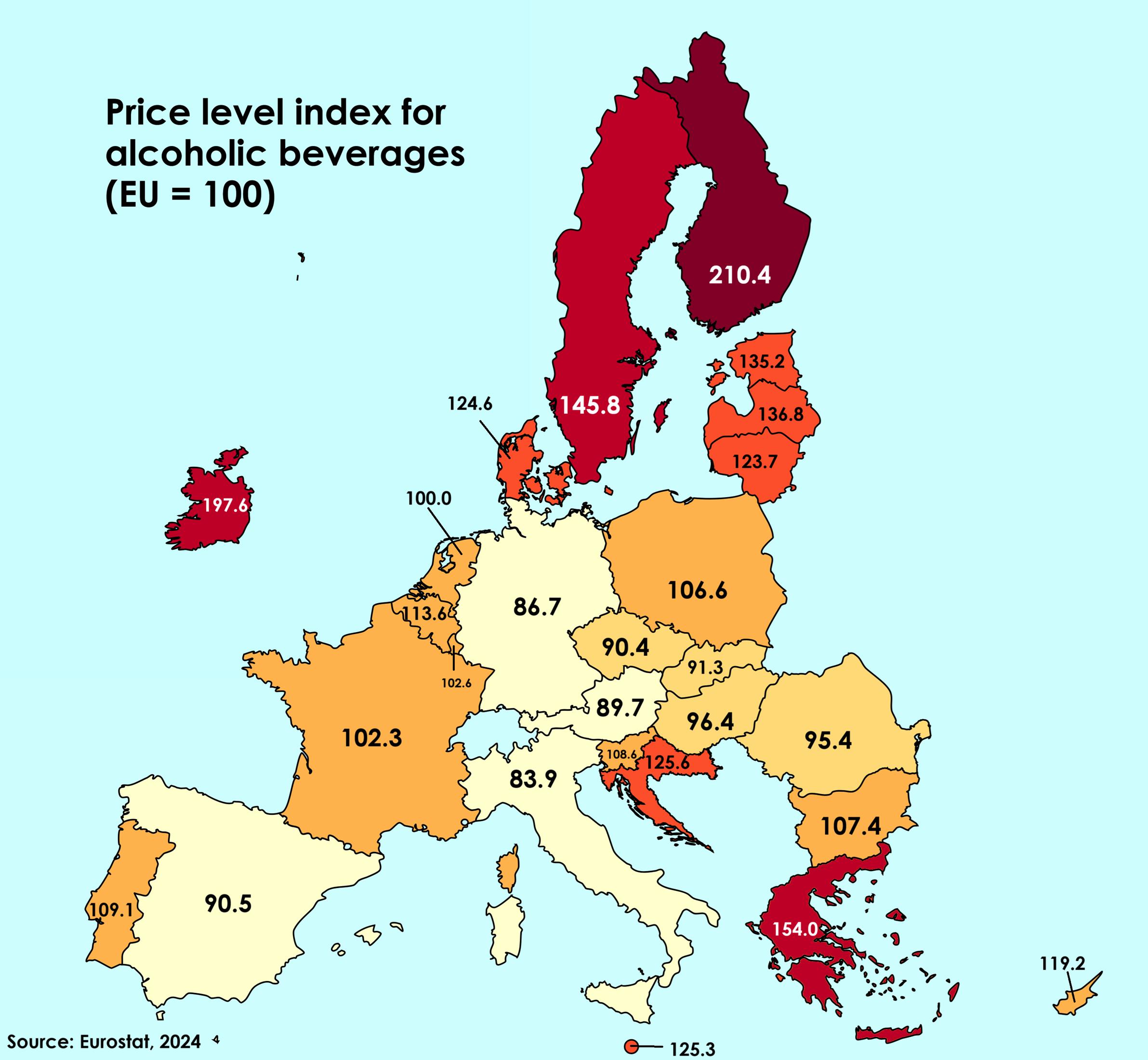Price Level Index for Alcoholic Beverages Map


David Chen
Data Visualization Specialist
David Chen is an expert in transforming complex geographic datasets into compelling visual narratives. He combines his background in computer science ...
Geographic Analysis
What This Map Shows
The "Price Level Index for Alcoholic Beverages" map provides a comparative visualization of the costs associated with alcoholic drinks across various countries. By assessing the price levels, this map offers insights into how the cost of alcohol varies globally, reflecting factors like local economies, taxation policies, and cultural attitudes towards drinking. This information is crucial for travelers, policymakers, and businesses alike, shedding light on consumer behavior and market opportunities.
Deep Dive into Alcohol Pricing
Alcohol pricing is influenced by a range of factors, including production costs, import tariffs, taxes, and cultural norms surrounding consumption. Interestingly, alcohol is not just a commodity; it often reflects societal values and economic conditions. For instance, countries with high taxes on alcohol, such as Sweden and Norway, tend to have higher price levels, which are reflective of their strategies to curb excessive drinking and promote public health.
In contrast, nations with lower taxes, such as Mexico or some Eastern European countries, often have more accessible prices for alcoholic beverages. This disparity can also indicate the purchasing power of residents. For example, while a beer might cost $2 in the Czech Republic, it could be upwards of $10 in Norway. This significant difference highlights how local economic conditions and government policies shape the market for alcoholic beverages.
Additionally, the type of alcoholic beverage plays a critical role in pricing. Spirits, wines, and beers are often priced differently due to the production processes involved. For example, wines from regions like France or Italy can carry a premium due to their reputation and quality, while local beers in many countries can be quite affordable.
Moreover, consumer preferences and cultural practices surrounding alcohol consumption also contribute to the landscape of pricing. In countries where alcohol is woven into social and cultural fabric, prices may reflect not only production but also the demand driven by these traditions.
Regional Analysis
Examining the map reveals notable regional trends in the price level index for alcoholic beverages. In Western Europe, countries such as Finland and Denmark show extremely high price indices, largely due to high taxation and strict regulations. The Nordic model emphasizes public health, which significantly affects the pricing structure for alcohol.
Conversely, Southern and Eastern Europe, particularly countries like Hungary and Greece, exhibit lower price levels. This can be attributed to lower taxation rates and a more relaxed regulatory environment concerning alcohol sales. Interestingly, countries with a strong wine culture, like Portugal and Italy, often have affordable local wines, making them more accessible to both residents and tourists.
In North America, the United States presents a wide variance in pricing due to state-level regulations. States like New York and California have elevated prices compared to states like Texas, where tax policies are more lenient. Meanwhile, Canada often mirrors some European pricing strategies, with higher costs in provinces like British Columbia, which emphasizes responsible drinking.
In Asia, the pricing index varies significantly. Countries like Japan and South Korea have a high price level for imported alcoholic beverages, reflecting tariffs and the high demand for premium products. However, local drinks, such as sake or soju, remain relatively affordable and popular, highlighting distinct cultural consumption patterns.
Significance and Impact
Understanding the price level index for alcoholic beverages is not just an academic exercise; it has real-world implications. For instance, businesses looking to enter new markets must consider pricing strategies based on local conditions. Additionally, policymakers can utilize this information to evaluate the effectiveness of taxation policies and their impact on public health.
Moreover, as global travel continues to recover post-pandemic, tourists will find this map invaluable for budgeting their trips. They may opt for destinations where they can enjoy local beverages without breaking the bank, thereby impacting local economies.
As trends in alcohol consumption evolve, particularly with younger generations gravitating towards craft drinks and sustainable options, observing shifts in pricing will be essential. Future projections may suggest a rise in local production and consumption, impacting price levels as sustainability becomes a priority.
In conclusion, the "Price Level Index for Alcoholic Beverages" map serves as a vital tool for understanding global alcohol pricing dynamics, offering insights that extend beyond mere numbers to reflect cultural, economic, and social patterns around the world.
Visualization Details
- Published
- September 8, 2025
- Views
- 86
Comments
Loading comments...